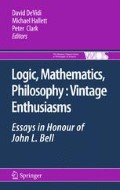Abstract
The philosophy of space and time did not begin with Newton and Leibniz, but there are perfectly good reasons why contemporary discussions see their origin in the controversy between those two. On the one hand, the issues explicitly raised between them—especially, and most obviously, the epistemological and methodological questions surrounding Newton’s theory of absolute space and motion—have never lost their relevance to the continuing evolution of physics. On the other hand, in different but equally unprecedented ways, they saw the question of the nature of space and time as part of a larger set of deeply interconnected questions, not only in the foundations of physics, but also in metaphysics, epistemology, and the foundations of mathematics.
Access this chapter
Tax calculation will be finalised at checkout
Purchases are for personal use only
Bibliography
Bell, J. L. (1998). A Primer of Infinitesimal Analysis. Cambridge University Press, Cambridge.
Bell, J. L. (2005). The Continuous and the Infinitesimal in Mathematics and Philosophy. Polimetrica, Milan.
Belot, G. and Earman, J. (2001). Pre-Socratic quantum gravity. In Callender, C. and Huggett, N., editors, Physics Meets Philosophy at the Planck Scale, pages 213–255. Cambridge University Press, Cambridge.
Butterfield, J. (1989). The hole truth. British Journal for the Philosophy of Science, 40:1–28.
DiSalle, R. (1994). On dynamics, indiscernibility, and spacetime ontology. British Journal for the Philosophy of Science, 45:265–287.
DiSalle, R. (1995). Spacetime theory as physical geometry. Erkenntnis, 42:317–337.
DiSalle, R. (2002). Newton’s philosophical analysis of space and time. In Cohen, I. and Smith, G., editors, The Cambridge Companion to Newton. Cambridge University Press, Cambridge.
DiSalle, R. (2006). Understanding Space-Time: The Philosophical Development of Physics from Newton to Einstein. Cambridge University Press, Cambridge.
Dorato, M. (2000). Substantivalism, relationalism, and structural spacetime realism. Foundations of Physics, 30:1605–1628.
Dorato, M. (2006). Is structural spacetime realism relationalism in disguise? The supererogatory nature of the substantivalism/relationalism debate. In Proceedings of the Second Montreal Conference on the Ontology of Spacetime, Concordia University, June 2006. http://philsci-archive.pitt.edu/archive/00003393/01/struct_spacfin.doc
Earman, J. (1989). World Enough and Spacetime: Absolute and Relational Theories of Motion. MIT Press, Cambridge, MA.
Earman, J. and Norton, J. (1987). What price spacetime substantivalism? The hole story. British Journal for the Philosophy of Science, 38:515–525.
Leibniz, G. (1692). Letter to S. Foucher. In Gerhardt, C., editor, Die philosophischen Schriften von Gottfried Wilhelm Leibniz (1960), volume I, pages 415–416. Georg Olms, Hildeshiem.
Leibniz, G. (1704). Nouveaux essais sur l’entendement. In Gerhardt, C., editor, Die philosophischen Schriften von Gottfried Wilhelm Leibniz (1960), volume V, pages 39–509. Georg Olms, Hildeshiem.
Leibniz, G. (1705). Letter to B. de Volder. In Gerhardt, C., editor, Die philosophischen Schriften von Gottfried Wilhelm Leibniz (1960), pages 278–279. Georg Olms, Hildeshiem.
Leibniz, G. (1715). Letter to L. Bourguet. In Gerhardt, C., editor, Die philosophischen Schriften von Gottfried Wilhelm Leibniz (1960), volume III, pages 578–583. Georg Olms, Hildeshiem.
Leibniz, G. (1716). Correspondence with S. Clarke. In Gerhardt, C., editor, Die philosophischen Schriften von Gottfried Wilhelm Leibniz (1960), volume VII, pages 345–440. Georg Olms, Hildeshiem.
Maudlin, T. (1990). Substances and space-time: What Aristotle would have said to einstein. Studies in History and Philosophy of Science, 21:531–561.
Maudlin, T. (1993). Buckets of water and waves of space: Why space-time is probably a substance. Philosophy of Science, 60, 183–203.
Misner, C., Thorne, K., and Wheeler, J. (1973). Gravitation. W.H. Freeman, New York.
Newton, I. (2005). On the gravity and equilibrium of fluids. In Janiak, A., editor, Newton’s Philosophical Writings. Cambridge University Press, Cambridge.
Quine, W. (1953). On what there is. In From a Logical Point of View. Harper, New York.
Riemann, B. (1867). Ueber die Hypothesen, welche der Geometrie zu Grunde liegen. In Weber, H., editor, The Collected Works of Bernhard Riemann, pages 272–287. B.G. Teubner, Leipzig. Published 1902. Reprint, New York: Dover Publications, 1956.
Russell, B. (1903). The Principles of Mathematics. Cambridge University Press, Cambridge.
Rynasiewicz, R. (1992). Rings, holes, and substantivalism: On the program of Leibniz algebras. Philosophy of Science, 59:572–589.
Smolin, L. (2005). The case for background independence. Technical Report 0507235, arXiv: High Energy Physics—Theory.
Stachel, J. (2002). The relations between things versus the things between relations: The deeper meaning of the hole argument. In Malament, D., editor, Reading Natural Philosophy: Essays in the History and Philosophy of Science and Mathematics to Honor Howard Stein on His 70th Birthday, pages 231–266. Open Court Press, Chicago IL.
Stachel, J. (2005). Structure, individuality, and quantum gravity. Technical Report 0507078v2, arXiv: General Relativity and Quantum Cosmology.
Stein, H. (1967). Newtonian space-time. Texas Quarterly, 10:174–200.
Weyl, H. (1927). Philosophie der Mathematik und der Naturwissenschaften. R. Oldenburg Verlag, Munich and Berlin.
Author information
Authors and Affiliations
Corresponding author
Editor information
Editors and Affiliations
Rights and permissions
Copyright information
© 2011 Springer Science+Business Media B.V.
About this chapter
Cite this chapter
DiSalle, R. (2011). Pitholes in Space-Time: Structure and Ontology of Physical Geometry. In: DeVidi, D., Hallett, M., Clarke, P. (eds) Logic, Mathematics, Philosophy, Vintage Enthusiasms. The Western Ontario Series in Philosophy of Science, vol 75. Springer, Dordrecht. https://doi.org/10.1007/978-94-007-0214-1_17
Download citation
DOI: https://doi.org/10.1007/978-94-007-0214-1_17
Published:
Publisher Name: Springer, Dordrecht
Print ISBN: 978-94-007-0213-4
Online ISBN: 978-94-007-0214-1
eBook Packages: Humanities, Social Sciences and LawPhilosophy and Religion (R0)

